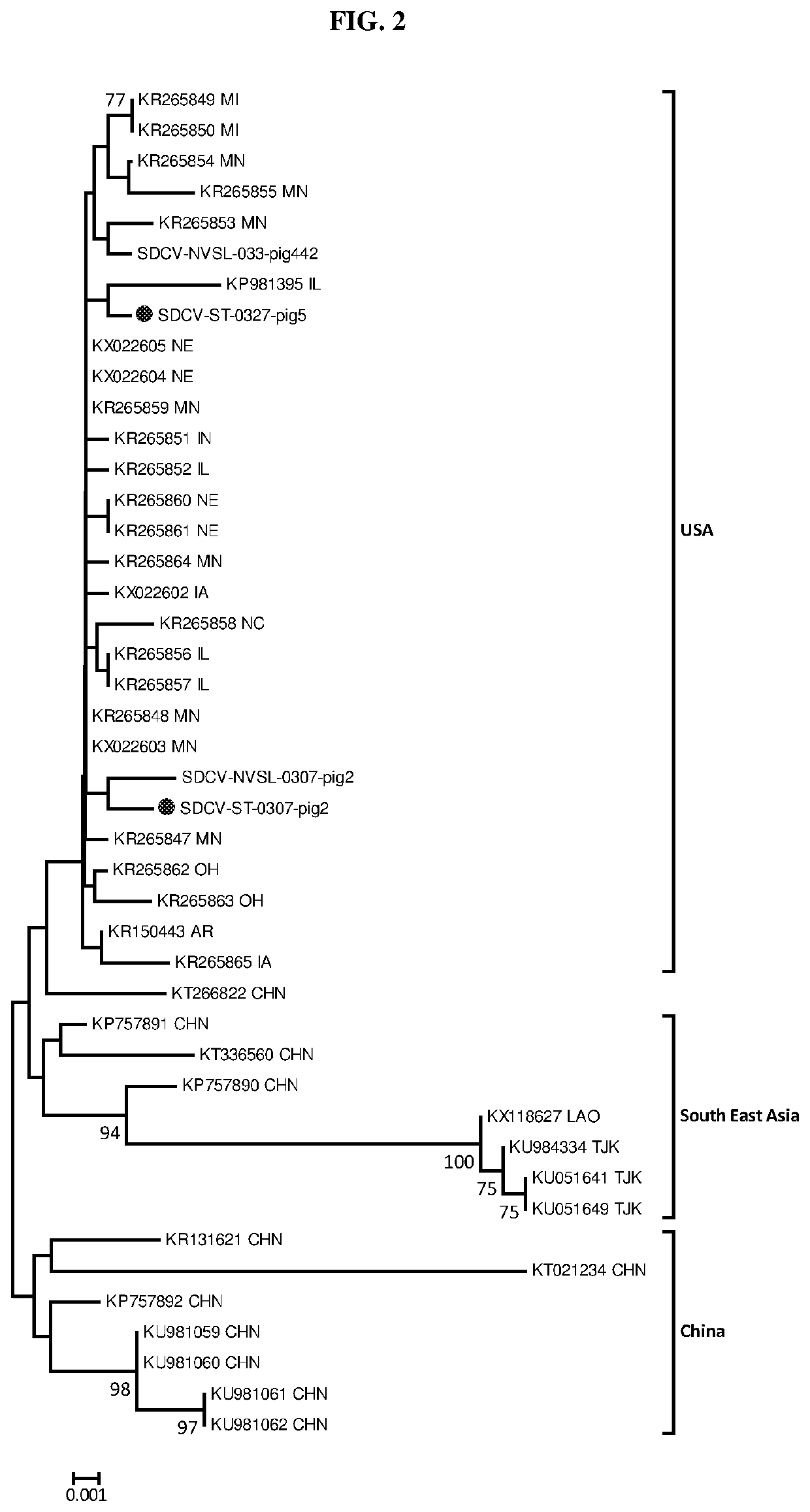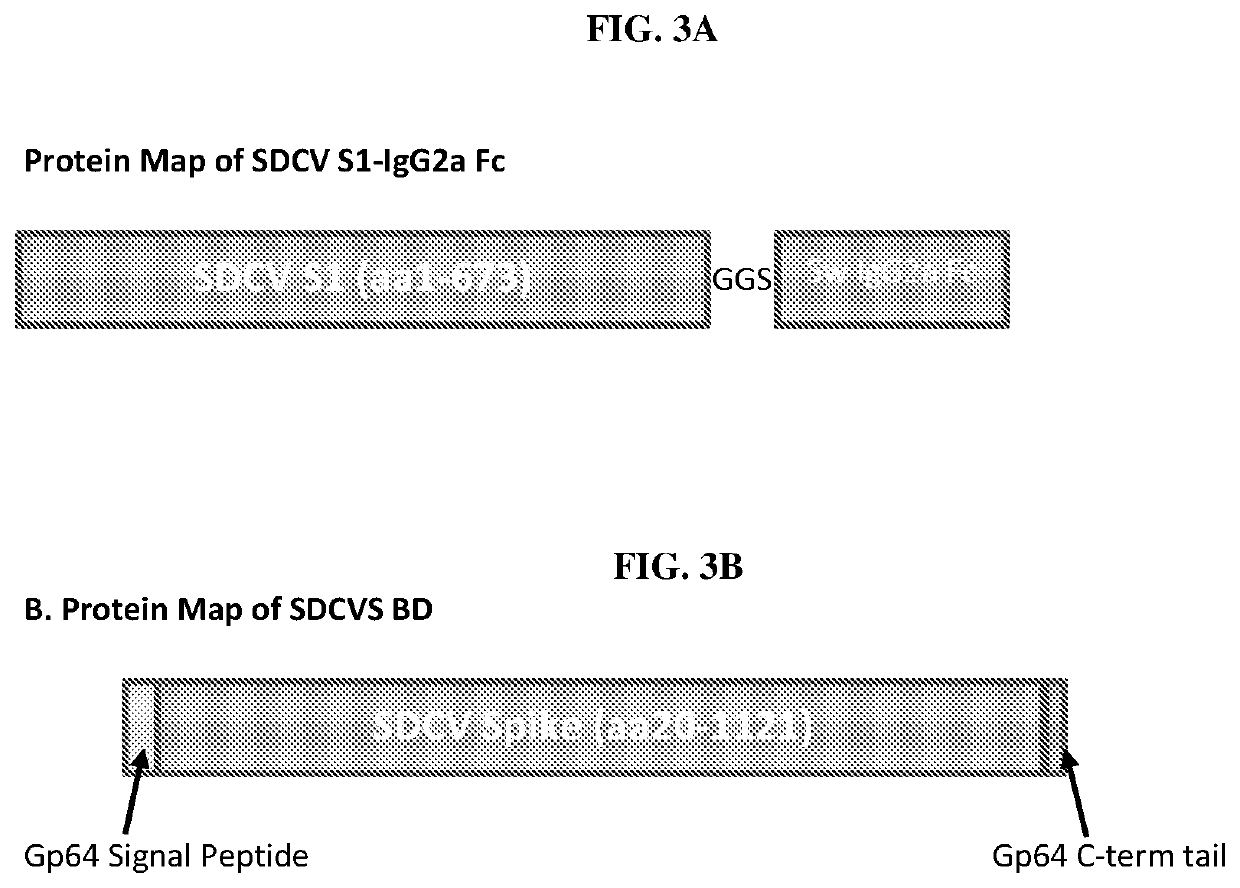Porcine coronavirus vaccines
a coronavirus and vaccine technology, applied in the field of immunogenic compositions, can solve the problems of insufficient economic importance of disease caused by pedv, no fully licensed vaccine is commercially available in the united states, and become increasingly problematic, so as to overcome deficiencies in the art and reduce clinical symptoms.
- Summary
- Abstract
- Description
- Claims
- Application Information
AI Technical Summary
Benefits of technology
Problems solved by technology
Method used
Image
Examples
example 1
and Production of PEDV Strain
[0179]To produce the porcine epidemic diarrhea virus vaccine, killed virus, a master seed culture of a PEDV (isolate) was first produced. From this master seed, a culture of PEDV was grown and then inactivated. The inactivated virus culture was then mixed with an adjuvant in order to produce the porcine epidemic diarrhea virus vaccine. The following method was used to produce the porcine epidemic diarrhea virus vaccine.
[0180]Animals or tissues from animals exhibiting extreme diarrhea were acquired in 2013. Homogenates from mucosal scrapings were generated from these animals filtered through a 0.2 micron syringe filter and the filtrate was used to inoculate African Green Monkey kidney cells (VERO). Virus was grown in the presence of PEDV maintenance media containing modified MEM, porcine trypsin, tryptose phosphate broth, yeast extract and HEPES buffer. Virus growth was evaluated and visualized by checking for characteristic syncytia formation and fusion ...
example 2
and Production of Porcine Deltacoronavirus Strain
[0186]The Porcine Deltacoronavirus (PDCoV) was purchased from the National Veterinary Service laboratory (NVSL), Ames, Iowa. This virus was isolated at NVSL from a swine intestinal sample from Illinois in 2014. The virus was isolated on Swine testes (ST) cells in serum free media in the presence of 5 μg / mL TPCK trypsin. The original virus went through two rounds of plaque purification at NVSL and the tenth passage of the virus was utilized as the starting material.
[0187]The pass 10 virus was inoculated and adapted to swine testes (ST) cells at BI with PDCoV maintenance media that contained Modified Minimal Essential Media with HEPES, tryptose phosphate broth, yeast extract and porcine trypsin. The cells were incubated at 24-48 hours at 37° C. with 5% CO2 and observed for evidence of PDCoV-induced cytopathic effect. When the CPE was complete and cells had sloughed off, the flasks were freeze-thawed once and the lysate was harvested. Th...
example 3
quence Analysis of PEDV Isolate and PDCoV Isolate
Sample Preparation and Analysis
[0188]Prior to extraction virus tissue culture supernatants were pre-treated with a cocktail of DNase and RNase to remove residual host cell genomic nucleic acids. Viral genomic RNA was then extracted from the nuclease-treated samples using the RNEASY® viral RNA extraction kit (Qiagen, Cat #52906). Post extraction, samples were again treated with DNase to further enrich for viral genomic RNA. Subsequently, viral genomic RNA was converted to double stranded cDNA (ds cDNA) through randomly primed reverse transcription and Klenow fragment treatment. The ds cDNA products were then used to generate a library for Illumina MISEQ® sequencer-based sequencing using the NEXTERA®XT library preparation kit (Cat #FC-131-1024). Each sample was barcoded with unique tags on both the 5′- and 3′-ends to minimize the chances of bioinformatic mis-binning. This library was run on the MISEQ® sequencer using the 500-cycle kit (...
PUM
| Property | Measurement | Unit |
|---|---|---|
| immunogenic composition | aaaaa | aaaaa |
Abstract
Description
Claims
Application Information
 Login to View More
Login to View More - R&D
- Intellectual Property
- Life Sciences
- Materials
- Tech Scout
- Unparalleled Data Quality
- Higher Quality Content
- 60% Fewer Hallucinations
Browse by: Latest US Patents, China's latest patents, Technical Efficacy Thesaurus, Application Domain, Technology Topic, Popular Technical Reports.
© 2025 PatSnap. All rights reserved.Legal|Privacy policy|Modern Slavery Act Transparency Statement|Sitemap|About US| Contact US: help@patsnap.com



